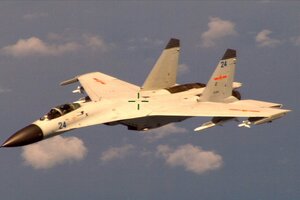China dismisses US complaints about jet fighter intercept
China argues that the close encounter between one of its jets and a US reconnaissance plane over the South China Sea was routine and that US surveillance in the area is provocative.

A US government handout with a picture of the Chinese plane that the Pentagon alleges carried out a "dangerous intercept" with a US Navy reconnaissance plane off the Chinese coast.
OSD handout
Beijing
Washington’s protest over a Chinese fighter jet that confronted a US jet by making three close passes was dismissed flatly this weekend by a Chinese defense official who said the fighter pilot acted “professionally” and kept a safe distance in what was a “routine” flight.
In the account of Rear Adm. John Kirby on Friday in Washington, the Chinese jet came within 20 feet of the wingtip of a P-8 patrol aircraft flying a surveillance mission 140 miles off the coast of Hainan Island in the South China Sea and at one point conducted a combat roll over the jet – bringing to mind a similar incident in 2001 where a Chinese fighter collided with a US plane about 70 miles off the Chinese coast and crashed.
The latest incident, and the divergent accounts of it, is the continuation of a long period of posturing between the US and China in the East Asian Pacific and the South China Sea – where a more assertive China claims vast amounts of ocean space and several islands that Japan considers its territory.
China this spring moved an oil rig into waters off the coast of Vietnam shortly after US President Barack Obama visited the region in a trip designed to assuage fears among Pacific nations like Japan and The Philippines that the US had not lost its willingness to provide security.
Last November China announced a broad new air defense zone over an island group that Japan calls the Senkaku and China calls Diaoyu – requiring aircraft that fly through the region to notify Beijing.
On Saturday Yang Yujun, spokesman for China’s National Defense Ministry, called the Pentagon account of the incident “totally groundless.” He also questioned why the US was flying off the coast of China and said the reconnaissance and data-collecting flights were themselves inherently dangerous and a cause of friction.
Saturday’s version of events from Beijing appeared to counter what US analysts thought was an earlier indication that the fighter had acted in a rogue manner.
The J-11 Chinese jet in last week’s incident was scrambled from the same base that pilot Wang Wei – who became a posthumous national hero in China -- took off from 13 years ago in his J-3 jet.
In 2001, the US craft was flying closer to China’s coast; the US plane was also damaged in the collision and forced to land at the Hainan airbase, where the US crew was detained for 10 days.
White House spokesman Ben Rhodes argued over the weekend that the Pentagon has been steadily seeking better relations with the Chinese military, and China watchers point to a long history of military exchanges with the People’s Republic:
“We’ve encouraged constructive military-to-military ties with China,” Mr. Rhodes told reporters, “and this type of action clearly violates the spirit of that engagement.”

